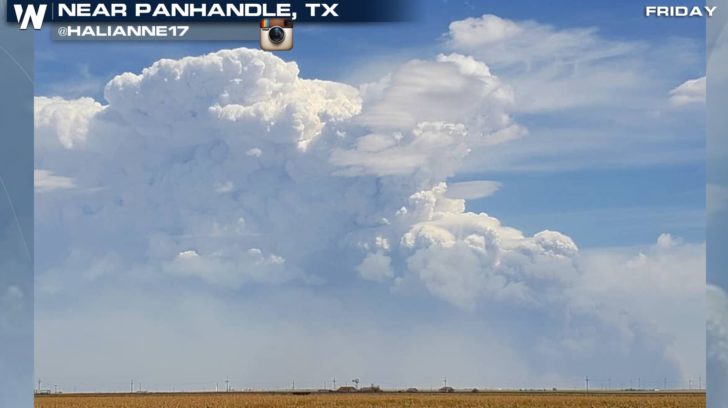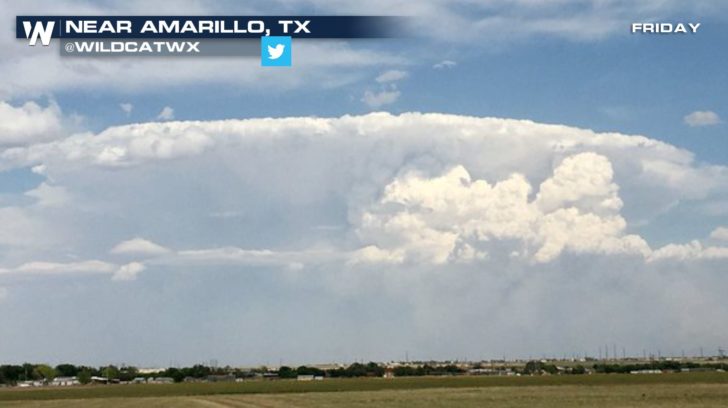MUST SEE: "Pyrocumulonimbus" Cloud Friday in Texas
Special Stories
11 May 2018 10:45 PM
A rare "pyrocumulonimbus" cloud formed in northern Texas Friday and the thunderstorm then proceeded ending up being severe and even dropping hail! All of this happening from an ongoing wildfire!
 Courtesy Instagram user Halianne17
Courtesy Instagram user Halianne17
 Courtesy Twitter user Wildcatwx
The Mallard Fire had burned about 35,000 acres Friday east of Amarillo, Texas. Then, an approaching front called a 'dry line' approached and helped boost temperatures close to 100 degrees while bringing in 40 mile per hour wind gusts! At the same time, conditions became favorable for this cloud to form from off the wildfire!
Wondering how it forms? Here's an explanation:
https://twitter.com/SteveGlazier/status/995160058479624192
This type of cloud is referred to as a "cumulus flammagenitus."
Here's the definition from the World Meteorological Organization:
Courtesy Twitter user Wildcatwx
The Mallard Fire had burned about 35,000 acres Friday east of Amarillo, Texas. Then, an approaching front called a 'dry line' approached and helped boost temperatures close to 100 degrees while bringing in 40 mile per hour wind gusts! At the same time, conditions became favorable for this cloud to form from off the wildfire!
Wondering how it forms? Here's an explanation:
https://twitter.com/SteveGlazier/status/995160058479624192
This type of cloud is referred to as a "cumulus flammagenitus."
Here's the definition from the World Meteorological Organization:
 Courtesy Instagram user Halianne17
Courtesy Instagram user Halianne17
 Courtesy Twitter user Wildcatwx
The Mallard Fire had burned about 35,000 acres Friday east of Amarillo, Texas. Then, an approaching front called a 'dry line' approached and helped boost temperatures close to 100 degrees while bringing in 40 mile per hour wind gusts! At the same time, conditions became favorable for this cloud to form from off the wildfire!
Wondering how it forms? Here's an explanation:
https://twitter.com/SteveGlazier/status/995160058479624192
This type of cloud is referred to as a "cumulus flammagenitus."
Here's the definition from the World Meteorological Organization:
Courtesy Twitter user Wildcatwx
The Mallard Fire had burned about 35,000 acres Friday east of Amarillo, Texas. Then, an approaching front called a 'dry line' approached and helped boost temperatures close to 100 degrees while bringing in 40 mile per hour wind gusts! At the same time, conditions became favorable for this cloud to form from off the wildfire!
Wondering how it forms? Here's an explanation:
https://twitter.com/SteveGlazier/status/995160058479624192
This type of cloud is referred to as a "cumulus flammagenitus."
Here's the definition from the World Meteorological Organization:
"Clouds may develop as a consequence of convection initiated by heat from forest fires, wildfires or volcanic eruption activity. Clouds that are clearly observed to have originated as a consequence of localized natural heat sources, such as forest fires, wildfires or volcanic activity and which, at least in part, consist of water drops, will be given the name relevant to the genus followed, if appropriate, by the species, variety and any supplementary features, and finally by the special cloud name “flammagenitus.”
Courtesy the WMO: https://cloudatlas.wmo.int/flammagenitus.html You could really visually see this from space on Friday. Check it out! https://twitter.com/WeatherNation/status/995083103642120193 Have questions about the weather? Drop us a note on social media! For WeatherNation, Meteorologist Steve GlazierAll Weather News
More